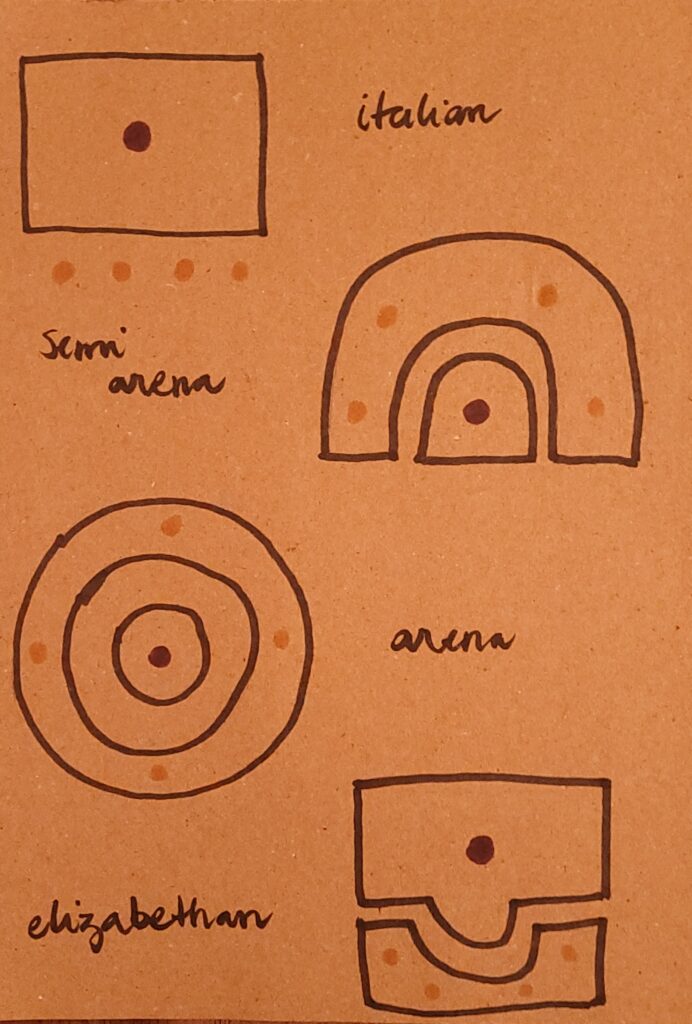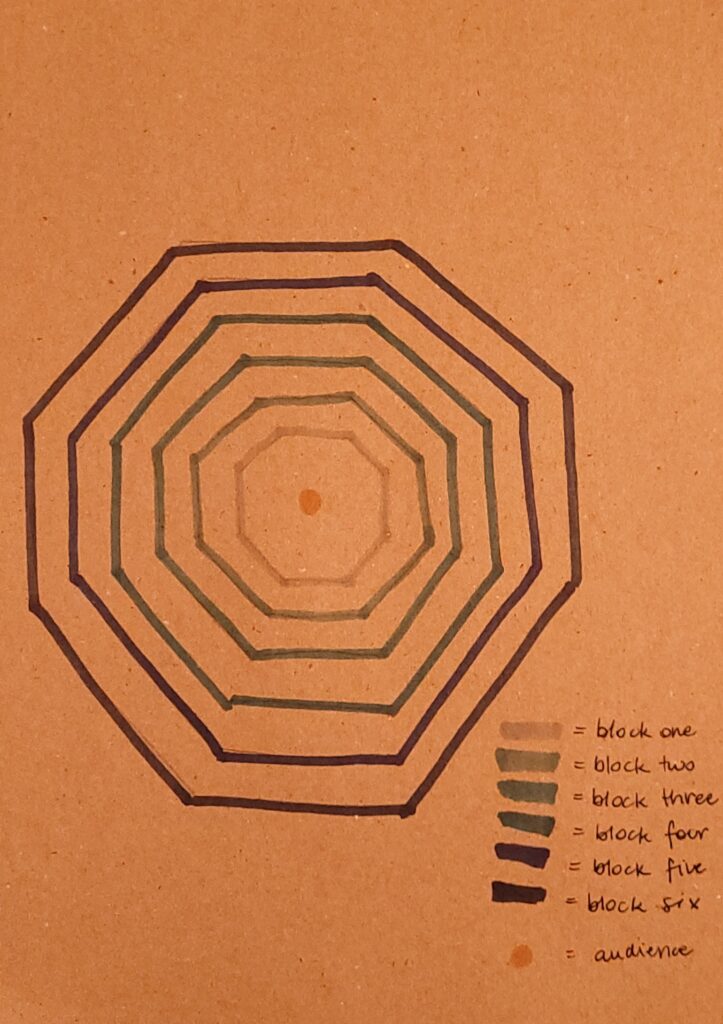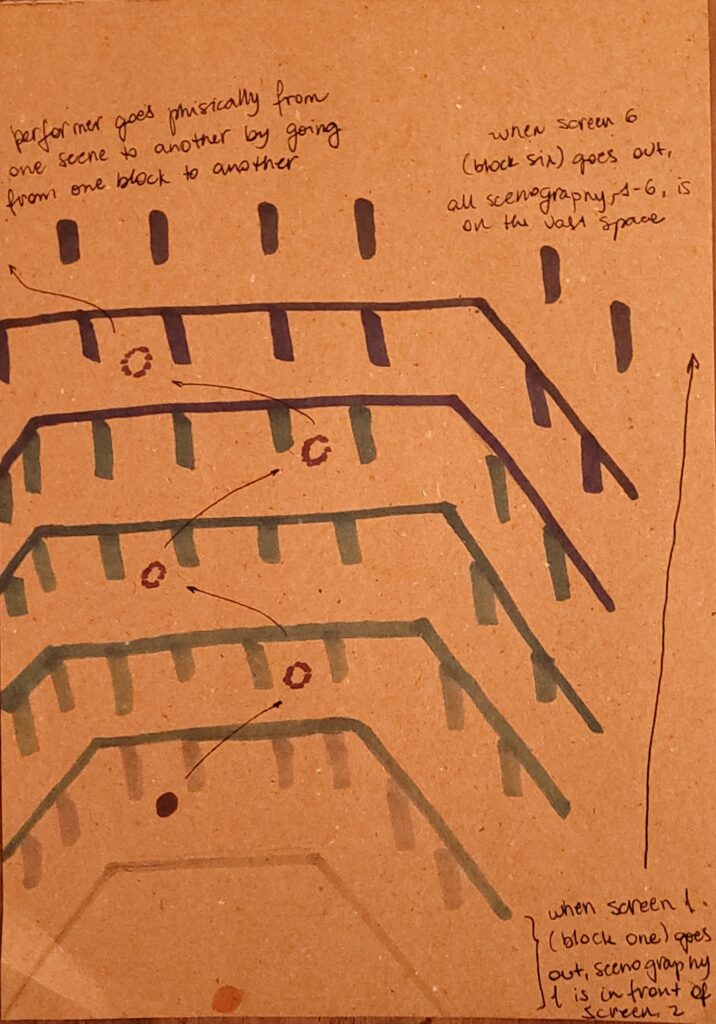In the clean version of the project the space can still be an installation, but in order to make it more accessible and avoid the participants having to walk, instead of them moving in order to see the space transform, the space itself will be a malleable body that would change over time with the performance.
To keep the immersive aspect of the space and narrative, I would avoid traditional stage settings. I am not keen to either Italian, semi-arena, arena nor elizabethan stage structures, because I believe all of them reinforce the gap between audience and performer, and put the performer in a place of superiority somehow. When these structures are used in performances that explore the limits of the artist on stage, which is my intention in this work and always, it also reinforces the misunderstanding of suffering as performance, and the performer being some sort of martyr to be admired. I deeply believe that these are a discreet toxicity of the same structures that divides performing arts languages.

That being said, I suggest imagining a stage setting that is neither a theater structure, nor an installation per se. The space would be an octogonal space with walls made of the holographic screen used in the complex version of the project. The space would have different layers of screen, one being set in the back of the previous one, each representing one block, one scene or one act of the performance.
In the examples below, the audience is represented by an orange dot and the performer is being represented by a purple dot. The audience is placed in the middle of the space. They can see that there are many layers of scenography there, but only the closest one is lit up and clear to see. In other words – they can only see what is happening behind the closest screen to them, and what is being projected in this screen. In the drawing on the left, the first screen is represented by block one.
As one block/scene/act ends, the attention is brought to the next layer of screen, the next further one – so, in the drawing on the left, block two. I will run some tests to investigate if this could happen by simply illuminating and projecting on the second screen, but I believe that the first layer would have to be lifted or brought down somehow. This could also happen by having one screen that is being expanded over time: one screen, that starts at the location signalized as block one, being brought back into the location signalized as block two in the second scene, to location signalized as block three in the third screen, and so on.
No matter how this movement happens, this would make the space where the audience is located wider, which would give the sensation of immensity and loneliness over time. The movement of the screen(s) should be smooth and discreet, so that the participants take some time to realize that the space is gradually wider and therefore, they are gradually more alone in an immense space. This can be done by getting their attention to one side of the octagonal structure, while another side moves.


Regarding scenographic elements, it depends a little on the narrative for there to be a necessity of having physical elements on the space. I believe that would be interesting so that the experience is not only physical and digital, but also plastic. As one block/scene/act ends and the screen is discreetly pulled away from the audience, the elements seen behind the screen are now located in front of it, in the same space as the audience member. For that to be discreet enough and the audience don’t realize, one side where the participants view reaches should host a performance or digital experience, while the other side moves and lets the elements be part of the space where they are located.
See the example below. As sides one, two and three host a performance for the audience to look at, sides four, five, six, seven and eight move. As sides xxx host a performance, sides one, two and three move. This way, the participant doesn’t realize that the space is slowly expanding. In the situations where there are scenographic elements to be integrated to the space, the screens are first pulled up, then the structure is moved back, and only after that the screen is let down again, so that the elements do not fall as the screen passes. I won’t dedicate much time to the technicality of it now because very probably there will be almost no scenography, apart from the dunes (see last part of Block two in the complex version). If that is the case, the screens do not necessarily need to be pulled up in order to be set further from the audience member, it can smoothly pass on top of them.
The somewhat limiting technicality of this format is that it would be much harder for the installation to be a solo experience like the complex format. There would have to be several individual structures, that together would form a beehive format when seen from above. This is the only aspect of it that makes me rethink the space, because as said in the complex structure, I believe a big part of the experience would be to explore it individually.
Block one – coffee seeds for a neutral mind
Clean version
The clean version of this part can be the same as the complex, for now, since it doesn’t include many elements. In case the installation is changed to another format to host this experience, I will adapt, but still will be a space of transition from the outside world to this experience. For now, block one will simply be a path that guides the audience inside this space, same as in the complex version, but this time to enter a 360 setting that will host the performance.
Block two – absurd familiarity
Clean version
In a clean version of this block, only some resources would be kept. Assuming the format is still an installation:
The first part, with the screen, can be either kept, as in: audience’s movement is translated into data, which is again translated into pull force for the screen’s movement; the floor has different textures and materials according to the point in space; materials are related to content on screen. Or: audience does not move, the floor does, as in a moving walkway. Materials are put in different points of it, so the audience’s sensation related to the content on screen stays the same. The walkway’s movement is translated into data, which is translated into the speed of the video. So, for example, when video is at minute 1, the walkway would have moved until point 1, where materials on screen can be felt on the floor. With this second version, the work can be hosted by an installation or a move passive environment, where audience doesn’t have to move.
The second part, where participant sees the persona with a screen between them, is partially kept. The concept stays the same: audience on one side, performer on the other, but it can be the same screen of the previous part. This way, again, the audience wouldn’t have to move.
The third part, with the dunes, is trickier. For this sensation of immensity to be kept, either the audience would have to be redirected to another space, or the space be transformed so much that it is unrecognizable. I am more keen to the second option, but I absolutely do not want this to look like a cheap magic trick, like taking the screen down and revealing the back. Therefore, the plan is to, from the start, invest in changing lights so that the audience constantly have a dream-like sensation of the space being unpredictable. Also, invest in laser projectors instead of LED projectors, because their image is sharper and less affected by colorful lights.
Block three – it is not a dream
Clean version
The first part, with the dunes and hologram, stays the same. The glass-mirrors part can be adapted in two ways.
One way is for the space that is in front of them to be movable, which would also serve as a possibility for the dunes part. For example, see picture one on the last block of images. If the space before them rotates, that would transmit a sense of expanded spatiality, an environment that constantly changes. To take away the sensation of those immersive roller coasters, where the guests sit on a movable chair that guides them through the space, I would do the opposite, so: on top of investing in sharp light design and laser projectors, the space would constantly change, with the audience staying at the same place. So in the scene of the glass-mirrors, the audience would be aware that the scenography around them would be the same as the one behind the glass because they would be able to observe the changes on the space, at the same time that the trio of glasses move.
The other option for this part is for there to be only one glass-mirror, which changes according to the audience’s movements. The technicality behind this is similar to the one with the moving screen: a kinetic camera tracks the audience’s movements, which is translated into data, and with the help of the Isadora Software, again translated into projections. This would allow the audience to interact with the space more seamlessly. For example: when in front of the glass for the first time, like in the first glass-mirror of the complex version, a camera films the participant and projects it on the screen. Before the second part, where the performer and more scenography elements would appear, a queue can exist for it to happen, as in the performer talking to the participant through audio asking the person to move in a specific way if they want to dive deeper in the narrative. This movement would be tracked by the kinetic camera, which would be translated into data, and again translated into the elements added in the second part – in the complex version, written as part of the second glass-mirror. The same could happen for the transition for the third part.
Block four – I am space
Clean version
For the clean version, the concept stays the same, but the form changes a bit. It’s simple: instead of walking to find this elements repeating themselves until infinity, they stay where they are and very gradually these elements start spreading around them. This would have to have a moment of silence and partial darkness before the start, only enough for them to start wanting for something to happen, and I’m very interested in the explicitly stating through audio that this inquietude and anxiety is exactly what I propose that they are aware with this project, and invite them to embrace the silence.
In this part, the same technical strategy of the moving screen and the glass-mirrors can be used. So, after the elements slowly appear and take over the space, the audience’s movement can be tracked and translated into the elements movements. I imagine this not as dots on the space moving in the same rhythm and path the person moves, like many design exhibitions have already made, but rather as the person’s movements directing plastic resources that give back to the space. For example, let’s suppose that the repetitive elements on the ceiling are silicone pieces. When the participant moves, their movement can be translated into the movement of the pieces. The friction between them would generate a sound of rubber or latex rubbing, which would naturally give back to the space a sound that is technically directed by the audience.
Block five – the secret
Clean version
Since this will be one single space and the audience won’t enter a different structure, the space will have to transform by itself. In opposition to the complex version, where the audience is guided by a repetition of elements until block five, here the audience sees the elements begin to appear around them. This can be done with projections on the screens and elements being hung from the ceiling, or appearing around them by being thrown from behind the screens discreetly. The goal is that the participants see themselves completely immersed in the narrative, having nowhere to go but simultaneously feeling embraced by the elements of the performance, as said in the complex version about Bataille’s perspective of erotism.
Block six – I am infinite
Clean version
The last block is kept in the clean version the same as in the complex version. The only difference is that perhaps, when the screens go back and make the space wider, there is the option of more benches to appear, but that is not necessary. There will be instructions for the audience too explore the virtual spaces, that were technically always there around them, with their cellphones.